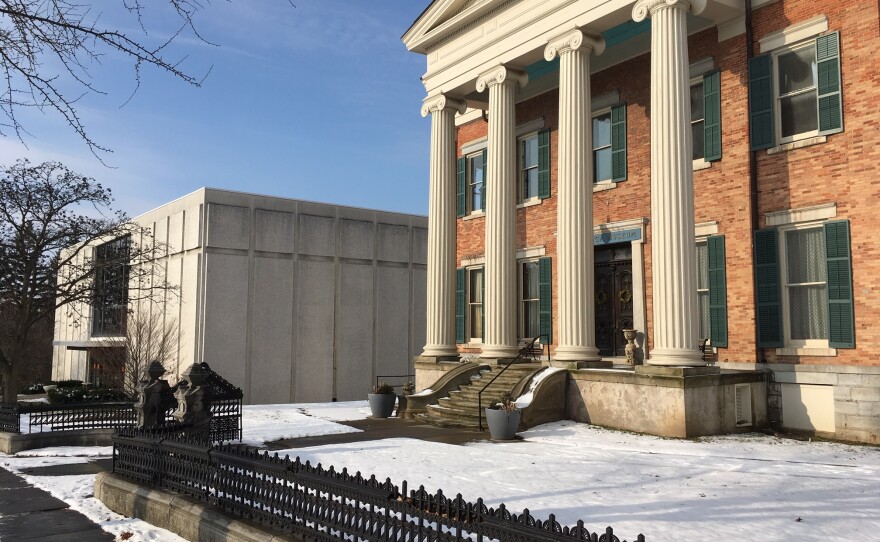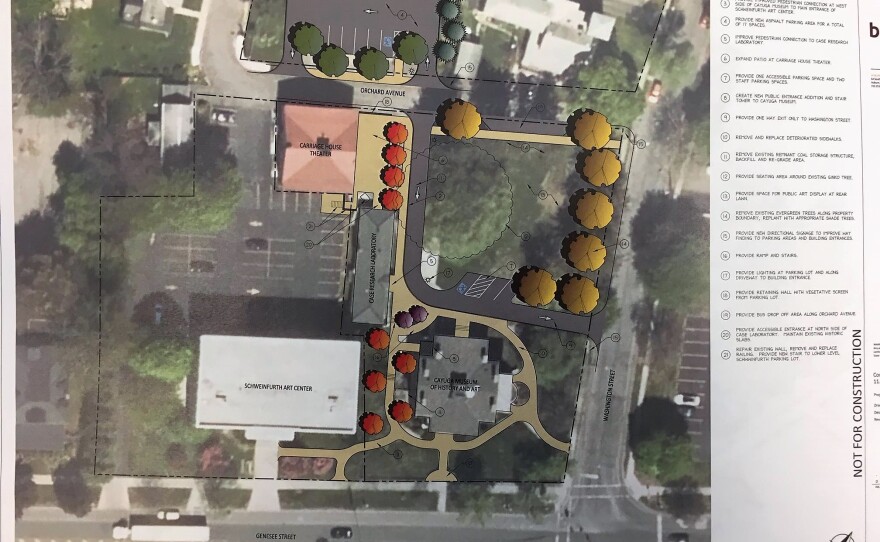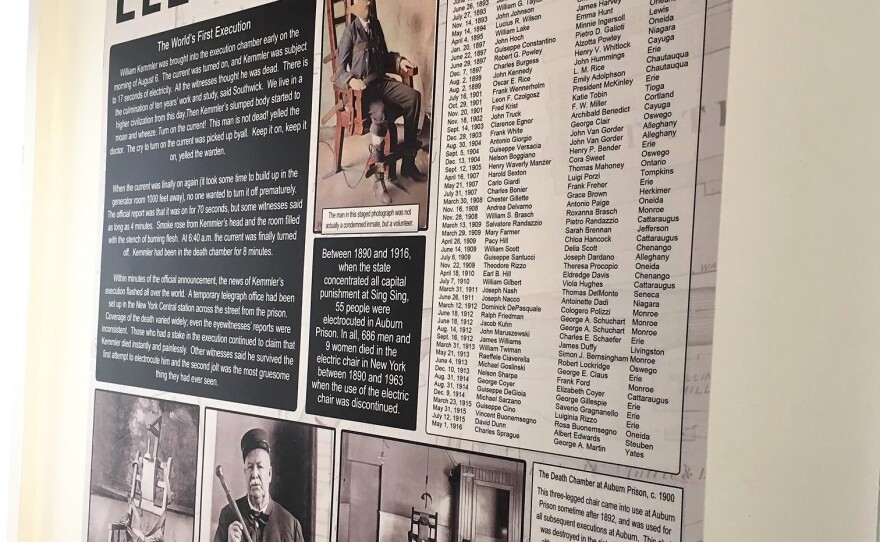The City of Auburn is known for its rich history. But the arts scene has also been gaining momentum in recent years, and the state is taking notice by supporting the efforts with significant grants. In part one of our story, we hear how art and history literally come together, on the west end of the city.
It seems only appropriate that the Cayuga Museum of History is housed in 1836 mansion, which itself has a long and interesting past. Two prominent families, the Willards and the Cases, lived there for nearly a century. The museum was founded in 1936.

"This was the original dining room of the home and we still have some of the original plasterwork and wallpaper from the 1840’s. Isn’t that cool?”
Executive director Kirsten Wise says Doctor Sylvester Willard built an addition for his dispensary and exam room.
"We have the full collection from the Cayuga County Medical Society from the 19th century. So we have a lot of pretty creepy things. We have a Civil War surgery kit right there.”
She says it’ll be part of a permanent exhibit, to go along with the one about Auburn Prison, which dates back more than two centuries. The museum’s artifacts touch just about every topic, and Wise points out a collection of mastodon bones to illustrate her point.
“A lot of the things that we have out are too big to fit in storage, really, but it’s nice to show the scope of the different things we have in our collection. Because our collection is really everything you can possibly think of from archeology to textiles to art to… You name it we probably have it upstairs.”
Art is where Wise is hoping to grow and branch out. She plans to continue a “CNY emerging artists project” where the museum features a different local artist each month with an opening reception.
“It was a huge success. I got a really great group of artists. We had a lot of new people come to the museum that have never been here before. So this year I’m actually doing it again, but I’m doing it on the main floor. Just to give it a completely different feel. Really excited about it.”
Patrons interested in art are also likely to make a stop right next door, at the Schweinfurth Art Center. Executive Director Donna Lamb sees the two serving as a gateway for a larger arts and entertainment district.

“Our vision is to expand our programming so that we can have things happening collaboratively and outdoors.”
What’s fueling this vision, you might ask? The city of Auburn recently won a $10 million downtown revitalization grant from the state that included a $1.1 million earmark for a west end arts campus.
“For many years we’ve tossed around the idea of how wonderful it would be if we could connect our properties more. So it would be easier for people to move from one place to another or park in one place and visit both institutions. So this is really a fantastic opportunity for us to take that project on.”
Kirsten Wise at the Cayuga Museum says the layout isn't all that welcoming.
“Right now, if you come to either of our sites you park in the back and look at the back of the building. We just want to make it look more inviting. We would add an entrance over here so that people don’t have to walk the whole way around to the front of the building so they could access any of them.”
“And the idea is that it becomes a destination where people can come experience our exhibits or participate in the program.”
Most visitors are likely to park at the rear of the Schweinfurth Art Center. From there you can easily see the Cayuga Museum of History as well as the 1850’s Carriage House and Case lab. While they’re all very close together, it’s not all that easy to get to each building. The topography of the sites combined with the lack of designated walkways makes it a little bit tricky to get around. Plans call for installing and expanding walkways, adding landscaping, lighting and signage, and generally making the venues more accessible.

The Schweinfurth also received a $250,000 matching state grant to replace its 38-year-old heating and air conditioning system. Donna Lamb says the upgrade will enable them to use the second floor of the museum year round, which currently lacks adequate ventilation for summer and winter. She plans to use the 5,000 square foot space for classes, artist workshops, and exhibits. Construction should begin this fall. Meanwhile, the Cayuga Museum has submitted a grant application to begin to stabilize the Case Research lab, where sound was put on film for the first time in the 1920’s.
AUBURN ARTS DISTRICT
All of this is in preparation for what could become an Auburn Arts District. The effort seems to be gaining momentum, thanks to decades of collaboration, and most recently, significant state support. Along with its reputation as "history’s hometown," Auburn is positioning itself as an arts and culture mecca.
Ask Auburn City Clerk Chuck Mason, and he’ll tell you everything finally seems to be lining up at the same time for different projects.
“The Tubman Home, in particular, that dates back to the 1990’s. Literally the first time we wrote the letters from the city perspective we were writing to Daniel Patrick Moynihan and Congressman Amo Houghton at the time. So it’s a long time coming for that project.”
Mason has been involved with the historic and cultural sites commission in some capacity since those early efforts to create a Harriet Tubman National Historical Park. The commission falls under the city clerk’s budget, and he provides staff support. Mason says members have always kept the big picture in mind.
“We’ve been doing this for a long time but one of the reasons why I think everything is coming together now, and there’s a lot of support for different things, is we’ve always successfully worked together.”
The collaboration among institutions, and potential economic impact, hasn’t gone unnoticed by New York State. The city of Auburn recently won a $10 million downtown revitalization grant from the state. Some of the money has been earmarked for improvements at the Schweinfurth Art Center and Cayuga Museum of History next door to make those institutions part of a west end arts campus that serves as a gateway to a larger arts district downtown. City Clerk Chuck Mason says the largely grassroots effort got a real boost in the previous decade.
“The Auburn Public Theater is people that got together 13, 14 years ago and they took the old Grant’s Department Store, which was empty, in Downtown Auburn and with a lot of elbow grease and a lot of diligent work to raise money and stuff they’ve slowly but surely pieced together what’s really the biggest attraction, now, in downtown Auburn.”

When you add the new Equal Rights Heritage Center down the block, the William Seward Museum right next door, and the Tubman National Park a mile south to the mix, you have what might be considered a critical mass of historic and cultural venues. Executive director of the Schweinfurth Art Center Donna Lamb says the more, the better.
“By working together we can help promote all of us to attract more cultural visitors. We’re well aware of the economic advantages of increasing more tourists and cultural visitors. The more cultural attractions we have, the more we’re likely to attract restaurants and brew pubs and retail outlets, and it all works together.”
Chuck Mason agrees.
“What we know is that arts and cultural events are big business for our local economy.”
Executive director of the Cayuga Museum of History Kirsten Wise says there is momentum.
“I’ve been here for almost six years and I have seen so much growth just since I’ve been around. And I think that what we have to offer is going to bring people here to the city.”
She says the state’s investment in the Equal rights center, plus the downtown revitalization grant makes it clear they believe in the culture Auburn has to offer. City Clerk Chuck Mason says there’s already been significant public and private investment.
“You know five years ago we had zero microbreweries in downtown Auburn. Now we have three microbreweries. We have specialty beer stores, specialty craft beverage store. We have coffee shops now. All of these things were not in our downtown five to ten years ago so there really is a resurgence happening.”
Mason fells downtown Auburn is about halfway into its comeback. He credits the dozens of volunteers and the small, underpaid staffs of the institutions for raising resources and making it happen.
“It’s a long time coming but things are finally starting to gel and things are finally starting to get the attention that they deserve here in downtown Auburn."


















